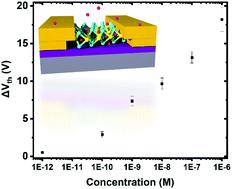Our official English website, www.x-mol.net, welcomes your feedback! (Note: you will need to create a separate account there.)
Field-effect-transistor-based ion sensors: ultrasensitive mercury(II) detection via healing MoS2 defects
Nanoscale ( IF 6.7 ) Pub Date : 2021-11-09 , DOI: 10.1039/d1nr05992k Fernando J Urbanos 1 , Sara Gullace 1 , Paolo Samorì 1
Nanoscale ( IF 6.7 ) Pub Date : 2021-11-09 , DOI: 10.1039/d1nr05992k Fernando J Urbanos 1 , Sara Gullace 1 , Paolo Samorì 1
Affiliation

|
The contamination of water with heavy metal ions represents a harsh environmental problem resulting from societal development. Among various hazardous compounds, mercury ions (Hg2+) surely belong to the most poisonous ones. Their accumulation in the human body results in health deterioration, affecting vital organs and eventually leading to chronic diseases, and, in the worst-case scenario, early death. High selectivity and sensitivity for the analyte of choice can be achieved in chemical sensing using suitable active materials capable of interacting at the supramolecular level with the chosen species. Among them, 2D transition metal dichalcogenides (TMDCs) have attracted great attention as sensory materials because of their unique physical and chemical properties, which are highly susceptible to environmental changes. In this work, we have fabricated MoS2-based field-effect transistors (FETs) and exploited them as platforms for Hg2+ sensing, relying on the affinity of heavy metal ions for both point defects in TMDCs and sulphur atoms in the MoS2 lattice. X-ray photoelectron spectroscopy characterization showed both a significant reduction of the defectiveness of MoS2 when exposed to Hg2+ with increasing concentration and a shift in the binding energy of 0.2 eV suggesting p-type doping of the 2D semiconductor. The efficient defect healing has been confirmed also by low-temperature photoluminescence measurements by monitoring the attenuation of defect-related bands after Hg2+ exposure. Transfer characteristics in MoS2 FETs provided further evidence that Hg2+ acts as a p-dopant of MoS2. Interestingly, we observed a strict correlation of doping with the concentration of Hg2+, following a semi-log trend. Hg2+ concentrations as low as 1 pM can be detected, being way below the limits imposed by health regulations. Electrical characterization also revealed that our sensor can be efficiently washed and used multiple times. Moreover, the developed devices displayed a markedly high selectivity for Hg2+ against other metal ions as ruled by soft/soft interaction among chemical systems with appropriate redox potentials, being a generally applicable approach to develop chemical sensing devices combining high sensitivity, selectivity and reversibility, to meet technological needs.
中文翻译:

基于场效应晶体管的离子传感器:通过修复二硫化钼缺陷进行超灵敏汞 (II) 检测
重金属离子对水的污染代表了社会发展带来的严峻环境问题。在各种有害化合物中,汞离子(Hg 2+) 肯定属于最毒的。它们在人体中的积累会导致健康恶化,影响重要器官并最终导致慢性疾病,在最坏的情况下会导致早逝。使用能够在超分子水平与所选物种相互作用的合适活性材料,可以在化学传感中实现对所选分析物的高选择性和灵敏度。其中,二维过渡金属二硫属化物(TMDCs)由于其独特的物理和化学性质,极易受环境变化的影响,作为感官材料受到了极大的关注。在这项工作中,我们制造了基于MoS 2的场效应晶体管 (FET) 并将它们用作 Hg 2+ 的平台传感,依赖于重金属离子对 TMDC 中的点缺陷和 MoS 2晶格中的硫原子的亲和力。X 射线光电子能谱表征表明,当暴露于 Hg 2+ 时,随着浓度的增加,MoS 2的缺陷显着降低,并且结合能的变化为 0.2 eV,表明 2D 半导体的 p 型掺杂。通过监测 Hg 2+暴露后缺陷相关带的衰减,低温光致发光测量也证实了有效的缺陷愈合。MoS 2 FET 中的转移特性进一步证明 Hg 2+作为 MoS 2的 p 掺杂剂. 有趣的是,我们观察到掺杂与 Hg 2+浓度之间存在严格的相关性,遵循半对数趋势。可以检测到低至 1 pM 的Hg 2+浓度,远低于卫生法规规定的限制。电气特性还表明,我们的传感器可以有效清洗和多次使用。此外,由于具有适当氧化还原电位的化学体系之间的软/软相互作用,所开发的设备对 Hg 2+对其他金属离子显示出显着的高选择性,是开发结合高灵敏度、选择性和可逆性的化学传感设备的普遍适用的方法,满足技术需求。
更新日期:2021-11-24
中文翻译:

基于场效应晶体管的离子传感器:通过修复二硫化钼缺陷进行超灵敏汞 (II) 检测
重金属离子对水的污染代表了社会发展带来的严峻环境问题。在各种有害化合物中,汞离子(Hg 2+) 肯定属于最毒的。它们在人体中的积累会导致健康恶化,影响重要器官并最终导致慢性疾病,在最坏的情况下会导致早逝。使用能够在超分子水平与所选物种相互作用的合适活性材料,可以在化学传感中实现对所选分析物的高选择性和灵敏度。其中,二维过渡金属二硫属化物(TMDCs)由于其独特的物理和化学性质,极易受环境变化的影响,作为感官材料受到了极大的关注。在这项工作中,我们制造了基于MoS 2的场效应晶体管 (FET) 并将它们用作 Hg 2+ 的平台传感,依赖于重金属离子对 TMDC 中的点缺陷和 MoS 2晶格中的硫原子的亲和力。X 射线光电子能谱表征表明,当暴露于 Hg 2+ 时,随着浓度的增加,MoS 2的缺陷显着降低,并且结合能的变化为 0.2 eV,表明 2D 半导体的 p 型掺杂。通过监测 Hg 2+暴露后缺陷相关带的衰减,低温光致发光测量也证实了有效的缺陷愈合。MoS 2 FET 中的转移特性进一步证明 Hg 2+作为 MoS 2的 p 掺杂剂. 有趣的是,我们观察到掺杂与 Hg 2+浓度之间存在严格的相关性,遵循半对数趋势。可以检测到低至 1 pM 的Hg 2+浓度,远低于卫生法规规定的限制。电气特性还表明,我们的传感器可以有效清洗和多次使用。此外,由于具有适当氧化还原电位的化学体系之间的软/软相互作用,所开发的设备对 Hg 2+对其他金属离子显示出显着的高选择性,是开发结合高灵敏度、选择性和可逆性的化学传感设备的普遍适用的方法,满足技术需求。



























 京公网安备 11010802027423号
京公网安备 11010802027423号